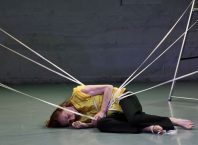“I don’t let just anyone into my bedroom,” says choreographer Rina Badash, yet in a sense, that is exactly what she does in “Revealed Under the Cover” an happening that will take place on Thursday, November 26, at the Tmuna Theatre in Tel Aviv. Badash invited filmmaker Miki Cohen to place a camera above her bed, documenting the body, space and events taking place there over time, the starting point for the creative process culminating in this artistic happening. Badash emphasizes that from her perspective it is an event, a happening, rather than a performance: “I am inviting the audience into my home, welcome to my home. I greet them when they come in. There is no distance between the audience and the stage. I want them to be comfortable.”
It is tempting to relate her work to the current trend of “reality” shows, yet the almost year long artistic process and conceptual underpinnings of the work are, as Badash says, “nothing like reality.” For Badash, a dancer and choreographer who was the Dance Advisor for the Municipality of Tel Aviv and currently teaches in the Dance Department of the Kibbutz Seminar, the project began when she noticed that she was not sleeping well at night and decided to try to observe the process in order to uncover the reasons. She invited Cohen to put a camera in her bedroom, and they arrived at a joint decision to place a small camera, the kind used for undercover surveillance, above her bed.
Once the process of filming and research began, Badash realized that she had embarked on an adventure: “Taking my bed as a starting point I had different images which we filmed and edited. From the beginning I saw a dance in this. There will be a dance, thank God. I hadn’t choreographed anything in 9 years.” The documentation of the bed, combined with the staged footage, is shown on four plasma screens interacting with dancer Shira Rosental and pianist Michael Ritzys. Ritzys improvises in response to what takes place onstage. Badash established certain anchors within the work, “places he has to reach” that create a framework for the improvisation. Says Badash, “He can decide to emphasize certain things or respond with a contrast. He responds from a male perspective, he is very much a man. I didn’t try to guide him or make him follow my path.”
Using her own body as the subject of the film, Badash is at once revealed and yet distanced from the work. “It’s not me anymore,” she says, “When I talk to Shira I speak of ‘the woman in the film.” Yet at the same time the camera observes Badash’s body from all angles, often from an invasive distance. “You can see my age,” says Badash, “You can see the less appealing parts of my body; it has defects. This proximity, this closeness is not beautiful. It’s not beautiful according to accepted aesthetic codes.”
Through images of the bed, the body and the dancer, Badash explores the associated feelings and concepts. “There is the image of a dancer as an artist, beautiful, great body. I do have a great body,” she smiles, and she does, “but I have my age, my experience, and my pain.”
Exploring the artistic space in terms of the personal, Badash describes the cinematic space as involving the elements of body, time and space. To represent the element of time that “fills the space of the bed,” she recounts, “I invited my family into my bed. I have always thought of us as a very loud happy family, I imagined that it would be fun. It turned out to be fun, but there just wasn’t enough room. We didn’t direct them in any way, they were only told to enter one after another in one minute intervals, and their response was up to them. It turns out that my family is loud, crazy and very cooperative –
“caring and involved” as they say in social work jargon.” Badash illustrates her words by placing her hand in a choke hold around her neck, smiling.
Each element of the work is the result of painstaking research, long conversations and hard work. Badash had many conversations with filmmaker Cohen on issues of intimacy and sexuality, each contributing the perspective of her or his own gender, which she now regrets not having video-taped – “it could have been source material for a project in it’s own right.” She worked with Shira Rosental on the dance solo for eight months. “Shira,” Badash describes, “is a very soft person in her body, but she is a perfectionist in the execution of the movement. She expresses both flexibility and precision.”
Describing the happening to take place at Tmuna, Badash says, “There is the video on the plasma screens and Shira dancing. You can look at the screens and flow with that story, or look at Shira and flow with that story, but when it all comes together the plot thickens.
Together with the audience the small stage takes on meaning, it becomes Shira’s bed. She is the mediator.” Badash expects that “the audience will come out of the experience and think about their beds. Asking themselves: how is it arranged, do I just sleep in it and leave? For some people, their bed is their entire world.”
How does Badash herself feel about the process? She smiles, “It was like a re-awakening.”
Performance: Thursday, November 26 at 20:30
Tmuna Theatre, 8 Soncino Street, Tel Aviv
Tickets: 03-5629462






